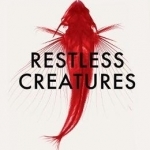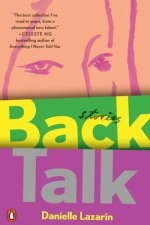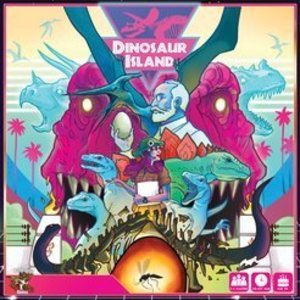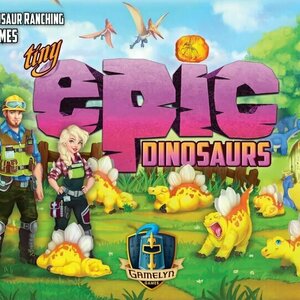LettieDC (17 KP) rated Dinosaur Island in Tabletop Games
Jan 2, 2019
It has 3 game stages you can choose depending on the amount of time you want to be playing.. short, medium and long game play which is great for when you can't be stuck playing for hours.
The aim of the game is to build a dinosaur island park with different dinosaurs and attractions within it. You gain excitement points for each dinosaur you add which increases the amount of visitors you can have per round. You also gain Victory points for every visitor who you manage not to get eaten!
The game pieces are all really well made and easy to use. It is difficult to fit back into the box but I see it as a mini tetris bonus game each time!
Well worth investing in this game as it can and will bring hours of fun and excitement.

It's Tyrannosaurus Rex - Smithsonian Institution
Book, Entertainment and Stickers
App
----- 33% OFF FOR A LIMITED TIME ----- Join Tyrannosaurus Rex, the fiercest predator in all the...

Restless Creatures: The Story of Life in Ten Movements
Book
A billion-year history of movement, from bacteria to Olympic athletes. 'Packed with revelations,...

Back Talk: Stories
Book
From an award-winning writer, a stunning collection of stories about women's unexpressed desires and...

A Land
Robert Macfarlane and Jacquetta Hawkes
Book
The Collins Nature Library is a new series of classic British nature writing - reissues of long-lost...

Natural Histories: 25 Extraordinary Species That Have Changed Our World
Stephen Moss and Brett Westwood
Book
Prepare to dive to the depths of the sea with 100-foot-long giant squid, travel through space after...

Video Walkthrough for Ark: Survival Evolved
Reference and Games
App
This is an unofficial video walkthrough for Ark: Survival Evolved. In 【Ark: Survival Evolved】,...
Purple Phoenix Games (2266 KP) rated Tiny Epic Dinosaurs in Tabletop Games
Jul 13, 2021
Tiny Epic Dinosaurs (TEDinos) is the latest release in the Tiny Epic line from Gamelyn Games and is a worker placement game of dinosaur enclosure, husbandry, and contract fulfilling for up to four enterprising ranchers. Players will be acquiring dinosaurs and barriers, feeding them, breeding them, and attempting to fulfill public and private contracts for maximum VP gains.
DISCLAIMER: I will be presenting this as a Solo Chronicles, where I will be using the Solo Rules included in the TEDinos rulebook. Also, I will not be covering every rule, as there are just too many to describe, but will give a general flow and feeling of the game to help inform your purchasing decision. -T
To setup TEDinos, follow all setup rules in the rulebook until you have something that looks like the photo above. All of the setup, save a few steps, is exactly like setting up for a multiplayer game, and the solo player will be playing the game exactly as if it were multiplayer.
The game lasts six rounds and each round is comprised of seven phases. The phases contain actions to be taken like Collect Resources (plants, meat, and supply boxes), Assign Ranchers (the meat of the worker placement game where your rancheeples and Lead Tomvaseleeple will be placed on action spaces), Retrieve Ranchers (to use them again next round), Arrange Ranch (to place your dinos in different enclosures), Feed Dinosaurs (obvious), Breed Dinosaurs (every like pair of dinos make a like dino), Refresh for Next Round (resetting card stacks and offers).
Again, I won’t go into detail about these phases, but will detail how the solo game differs a bit from the multiplayer. The Rival Rancher (AI player) will be taking actions in the second phase of every round, Assign Ranchers, but will do it using a card deck specific to the Rival Rancher. Initially the Rival Rancher will be 1st Player, so they will play a card from their deck during Assign Ranchers that will claim all of the action spaces on one of the Action Mats and give them a dineeple. For the player, should they wish to claim a spot on the same Action Mat that the Rival Rancher is sitting on, it will count as a meeple being there, so the player will need to expend their Lead Rancher or two normal Ranchers to claim a space.
This simulates another player claiming a space prior to the player’s turn, and spaces are still available, but with the added challenge of holding the Rival Rancher’s meeple. Play continues in this fashion until the end of the sixth round where player and Rival Rancher alike will add up VP to determine the winner.
Components. Like all Tiny Epic games, there are a TON of components packed into a tiny box. That is both a great thing and a challenging thing. TEDinos takes up about half of my dining table when all setup and played. So it does sprawl a little. However, many of the components are very very small and for big oaf-hands, the pieces can be fragile and cumbersome. It looks great on the table as the color palette used is fantastic (especially against a purple play surface), and the art is superb. All the components are great quality, but the meeples suffer a bit as they are so small; my copy came with several dineeples being damaged or headless or tailless or legless. That doesn’t necessarily bother me too much so I won’t bellyache about it. All in all the components are what we now expect from the Tiny Epic line.
The solo gameplay is really good and really REALLY difficult. I feel that if you don’t go into the game with a strategy ready to go you will flounder and be overwhelmed by the prowess of the AI Rival Rancher. I was the first time and I thought I would never be able to even come close to winning. But, the more I play the more I recognize different tactics to use in-game to help benefit my ranch effectively. Each AI player can use a different mat that offers different AI strategies and those are found on the back of the normal multiplayer mats. This is a phenomenal idea and offers great replayability, even for the solo plays.
Though the solo rules of TEDinos allow the AI player to be super tough, I find this to be one of the best in the Tiny Epic line. Tiny Epic Galaxies may still be my favorite, but I think TEDinos might be right behind. I can’t wait until this dino dropping-like virus is eradicated so I can play with my homies again, because I will certainly be pulling this one out quite a bit. I keep a spreadsheet of all my games in order of preference, and I admit that TEDinos has easily whomped its way into my Top 100, but will it get to Top 10 Games of All Time along with Tiny Epic Galaxies? I don’t know. Want to play and find out where it lands with you? Pick up a copy and have at it!
PS – I’m not one to shout out to other reviewers usually, but if you get a chance, do check out the Watch It Played video of this one. Rodney does a great job (as always) and helped me clear up some questions I had after reading the rule book.
Purple Phoenix Games (2266 KP) rated Fossilis in Tabletop Games
Feb 17, 2021
Fossilis is a game of set collection and tile placement in which players are working to excavate and collect sets of dinosaur bones for display in museums across the world. To setup for a game, prepare the dig site as described in the rulebook. Populate the Score Track board with 9 random Skill tokens, 3 face-down randomly selected Event cards, and a Plaster pool based on the player count. Create a Market of Tool and Supply cards, as well as a Dinosaur Display. Each player receives a mat, Paleontologist meeple, and score marker in their chosen color. Pick a starting player, and in reverse turn order, players place their Paleontologists onto a corner tile of the dig site. The game is now ready to begin!
Every players’ turn has 3 steps: Actions, Market, and Lab. At the start of your turn, you have 4 Energy to spend on Actions. The available action choices are: Gain 1 Plaster (from the Plaster pool), Move up to 2 spaces (orthogonally or diagonally), Climb onto the Dig Site (if your Paleontologist was knocked off the board), Place 1 Sand tile (anywhere on the Dig Site), Dig 1 tile (slide a terrain tile 1 space in any direction), or Extract (excavate a bone/hammer). With the exception of Digging, all other Actions cost 1 Energy to perform. Digging 1 tile costs energy dependent on the type of terrain tile being moved. To dig Sand is 1 Energy, Clay is 2, and Stone is 3. To Dig, you select 1 tile that is orthogonally adjacent to your Paleontologist, and slide it 1 space in any direction you wish. Tiles that are pushed off the edge are claimed by that player, and can be used to purchase cards from the Market. It is possible for a Paleontologist to be pushed off the Dig Site, so watch out! To perform the Extract action, you will excavate a bone or hammer from an open pit orthogonally adjacent to your Paleontologist. Extraction costs Plaster dependent on the type of bone being collected. For example, extracting a tooth costs 2 Plaster, while a skull costs 6. Extracting hammers has no cost, and you immediately trade the hammer for one of the available Skill tokens in play. The Skill tokens provide benefits for the remainder of the game. Once a player has spent their Energy, they move to the next phase.
On your turn, you may buy 1 card from the Market: either a Tool or Supply card. These are purchased using the icons on any tiles you collected during the Action phase. Supply cards gain you immediate resources, while Tool cards are saved for use during a future Action step. After the Market phase is the Lab phase. You may claim a Dinosaur from the Display if you have at least one of the required bones for that Dinosaur. You can only ever have 1 Dinosaur in your Lab at a time, so strategize carefully. At any point during a turn, you can score the Dinosaur in your lab – either for full points if all required bones are present on the card, or partial points if you only have some of the required bones.
Events are triggered 3 times throughout the game when the Plaster pool has been depleted. The active player draws the top Event card, and follows the instructions on the card. Once an Event has been performed, the Plaster pool is refilled and play continues with the next player. After the 3rd event has been triggered, the Plaster pool is refilled one last time. When the last Plaster pool is depleted for this final time, the game ends. Players count up all their points, and the player with the highest score wins!
At first it may seem overwhelming, like there is a lot going on, but after a couple of turns the gameplay feels intuitive and streamlined. There are quite a few aspects to keep track of, but the overall flow of the game makes it feel clear and concise. During my plays, I have never once felt lost or confused as to what the next turn step is. The tight gameplay also lends itself to providing a variety of strategic options for players. Do you want to go for all the highest-scoring Dinosaurs, even though their bones take longer to collect? Or maybe you want to snag as many lower-scoring Dinosaurs as possible, since they should be faster to collect. You can earn end-game points based on Characteristic sets of Dinosaurs (carnivorous, herbivore, etc), so maybe you decide to focus on those sets. Or if you’re in a particularly confrontational mood, maybe you want to knock opposing Paleontologists off the Dig Site, causing them to ‘waste’ an Energy on a future turn just to climb back on into the play area. There really is no right answer as to what strategy is a sure-win, and I like that I can choose and adapt my strategies based on the current standings in the game.
Probably my favorite innovative mechanic in Fossilis is the 3D terrain and ‘digging’ actions. When setting up the game, bones and hammers are randomly scattered and distributed around the Dig Site before terrain tiles are added. So there is absolutely no way to know where you should dig for what you want! Just like a real paleontologist, you’ve got to give it your best guess. I have had some frustrating turns, spending lots of Energy to dig a tile just to find the space to be empty! Or maybe you dig and hit the motherlode, which just means you’ll probably have to fight off other paleontologists for the bones that you need. The 3D board adds another element of strategy that heightens the gameplay and makes it more immersive.
Let’s touch on components for a moment. They are AWESOME. Admittedly, I have the Kickstarter version, but I just love how well-produced this game is. The terrain tiles are nice and thick bakelite-esque tiles, and they are just dang fun to manipulate. The plaster and bones are small, but pretty detailed and sturdy for their size. The artwork on the cards is colorful and clear, the Paleontologist meeples are cute little wooden bits, and the cardboard bits are all good quality. Excellent production quality all around.
It should come as no surprise, based on my score, that I love this game. The gameplay is immersive and engaging, the mechanics add a neat twist to your normal set collection/tile placement game, and the ability to adapt strategy on the fly means that nobody is truly out of the game because of one bad turn. Purple Phoenix Games gives Fossilis a roaring 11 / 12. If you’re looking for a good dinosaur game, look no further. Yeah, they’re technically just bones here, but it still counts!

Fiete Quiztime
Education and Games
App
It´s Quiztime! In this fun and educational trivia quiz, parents and children ages 4 and up can work...


